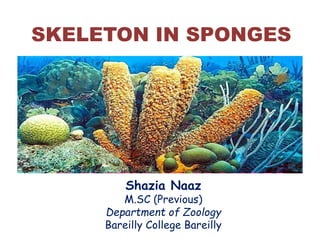
Skeleton in sponges by Shazia Naaz M.Sc. I year.pptx
- 1. Shazia Naaz M.SC (Previous) Department of Zoology Bareilly College Bareilly SKELETON IN SPONGES
- 2. Almost all sponges are provided with a skeleton Embedded in mesenchyme May consistof separate spicules or interlacing spongin fibers Supports & protects soft body parts Serves as basis of classification CONTENTS
- 4. 1. STRUCTURE & TYPES Spicules are crystalline structure Composed of spines or rays radiating form a point Secreted by specialized mesenchymal amoebocytes (scleroblasts)
- 5. All kinds of spicules have a core of organic material around which isdeposited either calcium carbonate (calcite) or colloidal silica (silicon) Accordingly they are of 2-types Calcareous (Calcarea) Siliceous (Hexactinellida)
- 6. According to size, larger spicules forming main skeleton (megascleres) Smaller spicules occurring interstitially (microscleres) May occur in several forms
- 7. May be simple rod-like, forks, anchors, shovels, stars, plumes etc. Forms depend upon the number of axes & rays present Can be divided into mono, tri, tetra or polyaxons
- 8. A. MONOAXON Formed by growth along one axis May be straight needle-like or curved Ends may be pointed, knobbed or hooked 2-kinds
- 9. B. TRIAXON With 3-axes t h a t cross each other at right angles to produce 6-rays Hexactinal Characteristic of glass sponges (Hexactinellida) only Euplectella, Hyalonema
- 10. C. TETRAXON With typically 4- rays each pointing in different direction Usually one of four rays is elongated giving appearance of a crown of 3- rays Termed triaenes
- 11. When all rays are equal (calthrops) When all rays persist (tetra or quadriradiate) When one of fours rays (elongated one) is lost (triradiate characteristic of calcareous sponges) Elongated ray with disc at both ends (amphidisc)
- 12. Amphidisc
- 13. Euplectella
- 14. Hyalonema
- 15. D. POLYAXON Spicules with several equal rays radiating form a central point May be grouped to give star-like appearance Common among microscleres
- 16. 2. DEVELOPMENT OF SPICULES Calcareous spicules are secreted byspecial cells (sclerocytes) derived from mesenchymal scleroblasts Monoaxon spicule or each ray of triradiate spiculeis secreted by a group of 2-sclerocytes
- 17. One acting as thickener cell Other as founder cell Binucleate scleroblast is believed to give rise to these cells Formation of spicule begins as a deposition of a particle of CaCO3 between 2- nuclei
- 18. Particle grows drawing apart first 2-nuclei & then 2- sclerocytes Thickener cell lays down additional layers of CaCO3 adding thickeness to spicule When spicule is fully formed, both cells wander into mesenchyme
- 19. Is an organic, elastic, horny substance resembling silk in chemical composition Like nails, hairs & feathers it is a scleroprotein containing Sulphur Chemically related to collagen Spongin fibre
- 20. Insoluble, chemically inert & resistant to protein digesting enzymes Contains a large amount of iodine 8-14% in certain tropical species (Spongiidae & Aplysinidae) Old herb doctors used bath sponge as a cure forcroup (throat condition of children due to inflammation & partial obstruction of larynx)
- 21. Occurs in various forms (Demospongiae) May occur as cement connecting together siliceous spicules (Monoaxonida: Cliona) More usually it is found in the form of branchingor anastomosing fibers in which siliceous spicules are embedded
- 22. Cliona
- 23. Euspongia